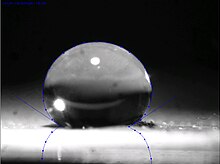
Back Ultrahidrofobicitat Catalan Ultrahidrofobicidad Spanish بساآبگریزی Persian Surface superhydrophobe French 超撥水 Japanese Super-hidrofobicidade Portuguese الٹرا آب گزیدگی Urdu

In chemistry and materials science, ultrahydrophobic (or superhydrophobic) surfaces are highly hydrophobic, i.e., extremely difficult to wet. The contact angles of a water droplet on an ultrahydrophobic material exceed 150°.[1] This is also referred to as the lotus effect, after the superhydrophobic leaves of the lotus plant. A droplet striking these kinds of surfaces can fully rebound like an elastic ball.[2] Interactions of bouncing drops can be further reduced using special superhydrophobic surfaces that promote symmetry breaking,[3][4][5][6] pancake bouncing[7] or waterbowl bouncing.[8][9]
- ^ Wang, Shutao; Jiang, L. (2007). "Definition of superhydrophobic states". Advanced Materials. 19 (21): 3423–3424. Bibcode:2007AdM....19.3423W. doi:10.1002/adma.200700934. S2CID 138017937.
- ^ Richard, Denis; Clanet, Christophe; Quéré, David (June 2002). "Contact time of a bouncing drop". Nature. 417 (6891): 811. doi:10.1038/417811a. PMID 12075341. S2CID 39405131.
- ^ Morgan, James (2013-11-21). "Waterproof surface is 'driest ever'". BBC News. Retrieved 2020-08-19.
- ^ "Physicists break theoretical time barrier on bouncing droplets (w/ Video)". phys.org. Retrieved 2020-08-19.
- ^ Bird, James C.; Dhiman, Rajeev; Kwon, Hyuk-Min; Varanasi, Kripa K. (November 2013). "Reducing the contact time of a bouncing drop". Nature. 503 (7476): 385–388. Bibcode:2013Natur.503..385B. doi:10.1038/nature12740. ISSN 1476-4687. PMID 24256803. S2CID 1329448.
- ^ Gauthier, Anaïs; Symon, Sean; Clanet, Christophe; Quéré, David (2015-08-11). "Water impacting on superhydrophobic macrotextures". Nature Communications. 6 (1): 8001. Bibcode:2015NatCo...6.8001G. doi:10.1038/ncomms9001. ISSN 2041-1723. PMC 4918367. PMID 26259509.
- ^ Liu, Yahua; Moevius, Lisa; Xu, Xinpeng; Qian, Tiezheng; Yeomans, Julia M.; Wang, Zuankai (8 June 2014). "Pancake bouncing on superhydrophobic surfaces". Nature Physics. 10 (7): 515–519. arXiv:1406.3203. Bibcode:2014NatPh..10..515L. doi:10.1038/nphys2980. PMC 5444522. PMID 28553363.
- ^ "How to make a better raincoat with tiny "water bowls"". The Economist. ISSN 0013-0613. Retrieved 2020-08-19.
- ^ Girard, Henri-Louis; Soto, Dan; Varanasi, Kripa K. (2019-07-23). "Waterbowls: Reducing Impacting Droplet Interactions by Momentum Redirection". ACS Nano. 13 (7): 7729–7735. doi:10.1021/acsnano.9b01301. ISSN 1936-0851. PMID 31243952. S2CID 195695075.